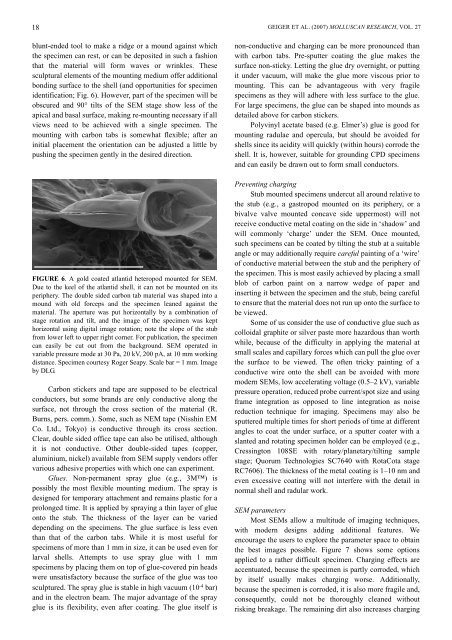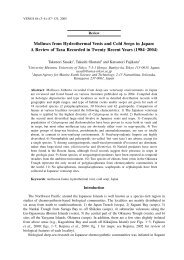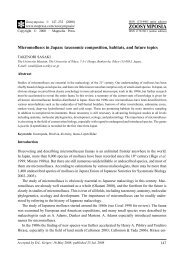Molluscan Research: Techniques for collecting, handling, preparing ...
Molluscan Research: Techniques for collecting, handling, preparing ...
Molluscan Research: Techniques for collecting, handling, preparing ...
Create successful ePaper yourself
Turn your PDF publications into a flip-book with our unique Google optimized e-Paper software.
18<br />
blunt-ended tool to make a ridge or a mound against which<br />
the specimen can rest, or can be deposited in such a fashion<br />
that the material will <strong>for</strong>m waves or wrinkles. These<br />
sculptural elements of the mounting medium offer additional<br />
bonding surface to the shell (and opportunities <strong>for</strong> specimen<br />
identification; Fig. 6). However, part of the specimen will be<br />
obscured and 90° tilts of the SEM stage show less of the<br />
apical and basal surface, making re-mounting necessary if all<br />
views need to be achieved with a single specimen. The<br />
mounting with carbon tabs is somewhat flexible; after an<br />
initial placement the orientation can be adjusted a little by<br />
pushing the specimen gently in the desired direction.<br />
FIGURE 6. A gold coated atlantid heteropod mounted <strong>for</strong> SEM.<br />
Due to the keel of the atlantid shell, it can not be mounted on its<br />
periphery. The double sided carbon tab material was shaped into a<br />
mound with old <strong>for</strong>ceps and the specimen leaned against the<br />
material. The aperture was put horizontally by a combination of<br />
stage rotation and tilt, and the image of the specimen was kept<br />
horizontal using digital image rotation; note the slope of the stub<br />
from lower left to upper right corner. For publication, the specimen<br />
can easily be cut out from the background. SEM operated in<br />
variable pressure mode at 30 Pa, 20 kV, 200 pA, at 10 mm working<br />
distance. Specimen courtesy Roger Seapy. Scale bar = 1 mm. Image<br />
by DLG.<br />
Carbon stickers and tape are supposed to be electrical<br />
conductors, but some brands are only conductive along the<br />
surface, not through the cross section of the material (R.<br />
Burns, pers. comm.). Some, such as NEM tape (Nisshin EM<br />
Co. Ltd., Tokyo) is conductive through its cross section.<br />
Clear, double sided office tape can also be utilised, although<br />
it is not conductive. Other double-sided tapes (copper,<br />
aluminium, nickel) available from SEM supply vendors offer<br />
various adhesive properties with which one can experiment.<br />
Glues. Non-permanent spray glue (e.g., 3M) is<br />
possibly the most flexible mounting medium. The spray is<br />
designed <strong>for</strong> temporary attachment and remains plastic <strong>for</strong> a<br />
prolonged time. It is applied by spraying a thin layer of glue<br />
onto the stub. The thickness of the layer can be varied<br />
depending on the specimens. The glue surface is less even<br />
than that of the carbon tabs. While it is most useful <strong>for</strong><br />
specimens of more than 1 mm in size, it can be used even <strong>for</strong><br />
larval shells. Attempts to use spray glue with 1 mm<br />
specimens by placing them on top of glue-covered pin heads<br />
were unsatisfactory because the surface of the glue was too<br />
sculptured. The spray glue is stable in high vacuum (10 -4 bar)<br />
and in the electron beam. The major advantage of the spray<br />
glue is its flexibility, even after coating. The glue itself is<br />
GEIGER ET AL. (2007) MOLLUSCAN RESEARCH, VOL. 27<br />
non-conductive and charging can be more pronounced than<br />
with carbon tabs. Pre-sputter coating the glue makes the<br />
surface non-sticky. Letting the glue dry overnight, or putting<br />
it under vacuum, will make the glue more viscous prior to<br />
mounting. This can be advantageous with very fragile<br />
specimens as they will adhere with less surface to the glue.<br />
For large specimens, the glue can be shaped into mounds as<br />
detailed above <strong>for</strong> carbon stickers.<br />
Polyvinyl acetate based (e.g. Elmer’s) glue is good <strong>for</strong><br />
mounting radulae and opercula, but should be avoided <strong>for</strong><br />
shells since its acidity will quickly (within hours) corrode the<br />
shell. It is, however, suitable <strong>for</strong> grounding CPD specimens<br />
and can easily be drawn out to <strong>for</strong>m small conductors.<br />
Preventing charging<br />
Stub mounted specimens undercut all around relative to<br />
the stub (e.g., a gastropod mounted on its periphery, or a<br />
bivalve valve mounted concave side uppermost) will not<br />
receive conductive metal coating on the side in ‘shadow’ and<br />
will commonly ‘charge’ under the SEM. Once mounted,<br />
such specimens can be coated by tilting the stub at a suitable<br />
angle or may additionally require careful painting of a ‘wire’<br />
of conductive material between the stub and the periphery of<br />
the specimen. This is most easily achieved by placing a small<br />
blob of carbon paint on a narrow wedge of paper and<br />
inserting it between the specimen and the stub, being careful<br />
to ensure that the material does not run up onto the surface to<br />
be viewed.<br />
Some of us consider the use of conductive glue such as<br />
colloidal graphite or silver paste more hazardous than worth<br />
while, because of the difficulty in applying the material at<br />
small scales and capillary <strong>for</strong>ces which can pull the glue over<br />
the surface to be viewed. The often tricky painting of a<br />
conductive wire onto the shell can be avoided with more<br />
modern SEMs, low accelerating voltage (0.5–2 kV), variable<br />
pressure operation, reduced probe current/spot size and using<br />
frame integration as opposed to line integration as noise<br />
reduction technique <strong>for</strong> imaging. Specimens may also be<br />
sputtered multiple times <strong>for</strong> short periods of time at different<br />
angles to coat the under surface, or a sputter coater with a<br />
slanted and rotating specimen holder can be employed (e.g.,<br />
Cressington 108SE with rotary/planetary/tilting sample<br />
stage; Quorum Technologies SC7640 with RotaCota stage<br />
RC7606). The thickness of the metal coating is 1–10 nm and<br />
even excessive coating will not interfere with the detail in<br />
normal shell and radular work.<br />
SEM parameters<br />
Most SEMs allow a multitude of imaging techniques,<br />
with modern designs adding additional features. We<br />
encourage the users to explore the parameter space to obtain<br />
the best images possible. Figure 7 shows some options<br />
applied to a rather difficult specimen. Charging effects are<br />
accentuated, because the specimen is partly corroded, which<br />
by itself usually makes charging worse. Additionally,<br />
because the specimen is corroded, it is also more fragile and,<br />
consequently, could not be thoroughly cleaned without<br />
risking breakage. The remaining dirt also increases charging




